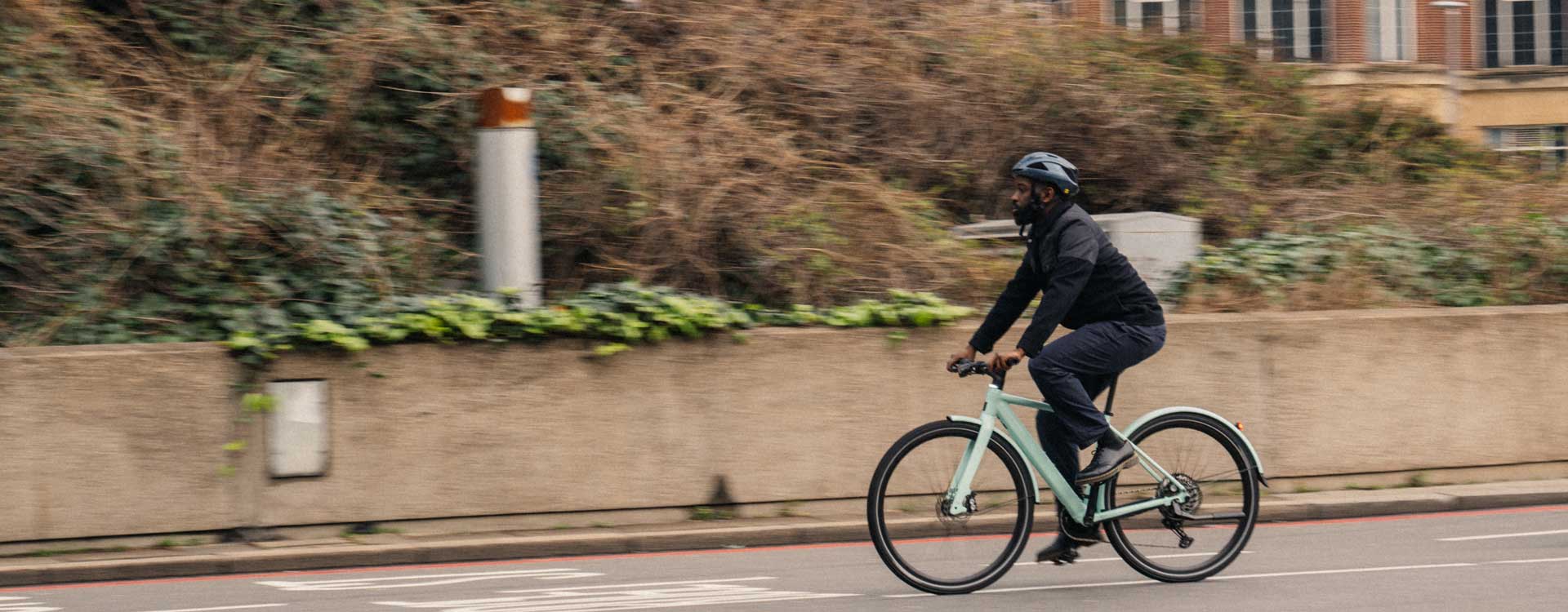Cheaper and greener than a car or public transport, commuting by bike also gets you fitter and is often quicker. In this guide, we take a look at four different types of bikes to help you find the best commuting companion for you.
Whether it's a bike to beat the rat race in the city or a machine that allows you to combine your commute with training, here at Sigma Sports we stock a large range of bikes and have experts on hand to help you choose.

Learn more about bikes for commuting
What makes a good bike for commuting?
Electric and non electric hybrid bikes
What makes a good bike for commuting?
Whilst any bike can be used for commuting, some are better suited to it than others, and by tailoring your bike to your particular needs the daily commute can be made easier and more fun. As a general rule though, bikes for commuting should be fairly robust to cope with daily use, comfortable in all weathers and needn’t cost the earth.
Electric and non electric hybrid bikes
What is a hybrid bike?
The term ‘hybrid’ is normally used to refer to a style of bike that is somewhere between a mountain bike and a road bike, covering a huge range of options. Typically they will have a flat handlebar and skinnier tyres than a mountain bike, but otherwise, there are few common denominators. These days, almost every style of hybrid bike is also available with an electric motor to provide assistance when required up to the UK legal limit of 25kph / 15.5mph, further adding to their convenience and utility as a commuting machine.
What are the benefits of a hybrid bike for commuting?
The biggest benefit of a hybrid bike is its versatility. A typical, middle-ground hybrid is faster than a mountain bike but more comfortable and robust than a road bike, usually with a less aggressive riding position too. This makes it more confidence-inspiring when riding amongst traffic in a city and better for riding on poorly surfaced urban roads. The larger volume tyres soak up bumps, kerbs and potholes better than a road bike without feeling as slow and cumbersome as a full-blown mountain bike.
What are the different types of hybrid bikes?
Hybrids come in almost every shape and form, ranging from nearly-a-mountain bike to nearly-a-road bike. Some have front suspension, some are kitted out with racks and mudguards whilst others are stripped back and sporty. The frame material can be steel, aluminium or even carbon fibre and there are even two distinct styles of frames on offer; the traditional diamond-shaped frame and the step-thru version that has a much lower ‘top tube’ that makes it easier to mount, dismount or put a foot down at traffic lights.
How to choose a hybrid bike for commuting
Consider carefully what you want to use the bike for, now and in the future, Whilst your route to work and cycling experience will probably point you towards a particular style or format of hybrid, it is also worth considering whether you might want to use the bike at the weekend for longer leisure rides, on or off-road. If so, this might skew your choice in a slightly different direction.

Electric and non electric folding bikes
What is an electric and non electric folding bike?
Folding bikes are brilliant for anyone who has to take their bike on public transport as part of their commute and / or has limited storage space at work or at home. With small wheels and a clever design, they can be folded down or rebuilt in seconds, yet are compact enough to carry onto a train or fit under a desk.
As with most types of bikes these days, folding bikes are available with and without an electric motor for assistance. This power is in addition to your pedalling input, not instead of it, and assistance can only be given up to the UK legal limit of 25kph / 15.5mph. This works well with folding style bikes as they are not typically ridden at high speeds anyway, and the design of the motor and battery does not impede the folding mechanism.
How to choose a folding bike for commuting
Although folding bikes are broadly similar in shape and form, you should make sure that the gears available are suitable for your particular commute. Some only come with a couple of gears as they are intended for short, flat rides whereas others have a bigger range of ratios and can be used on more challenging terrain.
Electric folding bikes will inevitably weigh a little more than the non-electric version, so it is handy that some models come with the battery in a bag that can be removed from the bike and carried separately. With others, the battery is attached to the bike and so must be carried as one unit which might be tricky for longer distances or stairs.
Also, make sure that the frame and handlebar style are comfortable for you as folding bikes typically come in fewer size options than other bikes and rely on a high degree of adjustability to achieve the right position for the rider.

Electric cargo bikes
What is an electric cargo bike?
An electric cargo bike is an incredibly useful blend of huge carrying capacity and power assistance that allows heavy loads to be carried with ease. Built with a very sturdy frame, these bikes are well suited to take the place of a car when carting the weekly shop home or ferrying the kids to school.
What are the benefits of an electric cargo bike for commuting?
Aside from the usual perks of being much better for the environment, far cheaper to run than a car and the significant health benefits of more exercise, an electric cargo bike is also easier to park than a car, carries a larger load than a normal bike and has the assistance of an electric motor.
What are the different types of electric cargo bikes?
Electric cargo bikes probably have the greatest variety of frame shapes of any genre of bike. Some are designed to carry a load up front, with an extended frame that houses the luggage area. Others are longer at the back to give more carrying capacity behind the rider and some look more like regular bikes but with very sturdy integrated racks. There are even tricycle-style electric cargo bikes that have greater stability and load capability.
How to choose an electric cargo bike for commuting
When choosing an electric cargo bike, you should consider its total load capacity and carrying space; the requirements for taking a child or two to school will be quite different to lugging the shopping home. You might also like to think about where and how you are going to store it as they are large and heavy machines that can take up quite a bit of space. As with all electric bikes, range is governed chiefly by battery size and assistance level, so if you are planning on doing a lot of miles or using high power modes with heavy loads, then pick a model with a larger battery.

Road and gravel bikes
What makes a good road or gravel bike for commuting?
Robustness and reliability are key here when commuting on a road or gravel bike; cutting edge materials and ultimate performance matters little on a bike that will be ridden day in, day out and in all weather conditions. The ability to fit good, full-length mudguards and perhaps even a rack for luggage is also hugely beneficial, making the bike as easy, convenient and comfortable as possible so that the commute is a pleasure, not a chore.
What are the benefits of using a road or gravel bike for commuting?
A dedicated road bike will undoubtedly be the quickest and most efficient way to cover a long, tarmac-based commute. The slick tyres roll easily along the road, your body will be in a position that is more aerodynamic and more efficient at producing power and the bike will be lighter than the other options here.
A gravel bike looks ostensibly similar to a road bike, but features wider tyres with knobbles on and has a slightly more relaxed geometry. Whilst the bigger tyres will be a little slower than dedicated road tyres, they are excellent at coping with potholed city roads, kerbs and speed bumps, so actually make a lot of sense in an urban environment. It will probably also have lower gearing that makes hills easier and is likely to have luggage and mudguard mounts built in for convenience.
What should you look for on a road or gravel bike for commuting?
The term ‘gravel bikes’ covers a huge range of bikes, from what are effectively drop bar mountain bikes to something more akin to a road bike with slightly bigger tyres. For commuting purposes, you will probably be best served with something at the lighter end of the market for greater efficiency, but one that still offers the possibility of mudguards and a rack.
Similarly, any commuting road bike should come equipped with mounts for luggage and mudguards for protection and convenience. Luckily, this style of bike is popular with serious riders for use as a bike to train on over the winter months, so there is a good choice available.
How to choose a road or gravel bike for commuting
Individuals with longer commutes and decent roads will be better served by a road bike whereas anyone who has to deal with a variety of surfaces or is lucky enough to have some off-road trails on their way to work will want to look at a gravel bike.
Whichever style of bike you opt for, look for mudguard and rack mounts, reasonably robust tyres and, most importantly, one which is comfortable for you to ride regularly.
How much should you spend on a road or gravel bike for commuting?
For less than £2,000, you can buy a reliable, lightweight road or gravel bike that will provide sterling service on the daily commute. More money will buy you a lighter bike with more premium components that riders with further to travel will benefit from, but there is no need to spend a fortune on a bike that might get wet and dirty frequently.
Shop all "commute-ready" road and gravel bikes







